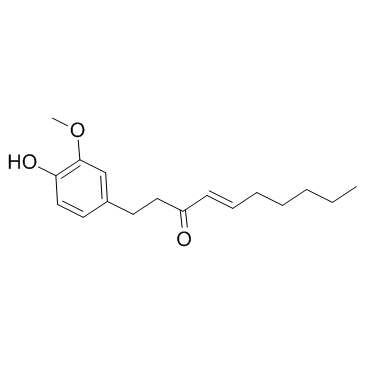555-66-8
| Name | (E)-1-(4-hydroxy-3-methoxyphenyl)dec-4-en-3-one |
|---|---|
| Synonyms |
(E)-1-(4-Hydroxy-3-methoxy-phenyl)-dec-4-en-3-one
(4E)-1-(4-Hydroxy-3-methoxyphenyl)dec-4-en-3-one 6-Shogaol Trans-6-Shogaol MFCD01736094 4-Decen-3-one, 1-(4-hydroxy-3-methoxyphenyl) Shogaol 4-Decen-3-one, 1-(4-hydroxy-3-methoxyphenyl)-, (4E)- (4E)-1-(4-Hydroxy-3-methoxyphenyl)-4-decen-3-one [6]-Shogaol |
| Description | 6-shogaol, an active compound isolated from Ginger (Zingiber officinale Rosc), exhibits a variety of biological activities including anticancer, anti-inflammation, and anti-oxidation. |
|---|---|
| Related Catalog | |
| In Vitro | 6-shogaol has anticancer activity against several cell lines[1]. 6-shogaol is identified to be cytotoxic in various cell lines, with KB (IC50=7.4±2.2 μM) and HL60 (IC50=7.9±2.0 μM) cells most susceptible to 6-shogaol[2]. 6-shogaol (IC50=8 μM) has much stronger growth inhibitory effects than 6-gingerol (IC50=150 μM) on HCT-116 human colon cancer cells[3]. 6-shogaol stimulates phosphorylations of mitogen-activated protein kinases (MAPKs) such as ERK, JNK, and p38. Moreover, the 6-shogaol-induced expressions of Nrf2 and HO-1 are attenuated by treatments of SB202190 (a p38 specific inhibitor) and LY294002 (an Akt specific inhibitor)[4]. |
| In Vivo | The 6-shogaol decreases the diethylnitrosamine (DEN)-mediated elevations of serum aspartate transaminase and alanine transaminase as well as the DEN-induced hepatic lipid peroxidation. Inductions of Nrf2 and HO-1 by 6-shogaol are also confirmed in the mice. The administration of 6-shogaol to the mice also restores the DEN-reduced activity and protein expression of hepatic antioxidant enzymes such as superoxide dismutase, glutathione peroxidase and catalase[4]. |
| Cell Assay | The effects of 6-shogaol on the viability of HepG2 cells are determined by a MTT assay after 24 h treatment. The data are expressed as percent cell viability compared to that of control. The concentrations of the treatments 6-shogaol varied from 10 to 100 μg/mL[4]. |
| Animal Admin | Mice: Male Balb/c mice are treated with 6-shogaol-rich ginger extracts (10 and 100 mg/kg b.w.) or silymarin (100 mg/kg b.w.), a positive control, and challenged with diethyl-nitrosoamine (DEN, 30 mg/kg b.w.) 3 days per week for 3 weeks[4]. |
| References |
| Density | 1.0±0.1 g/cm3 |
|---|---|
| Boiling Point | 427.5±35.0 °C at 760 mmHg |
| Molecular Formula | C17H24O3 |
| Molecular Weight | 276.371 |
| Flash Point | 150.3±19.4 °C |
| Exact Mass | 276.172546 |
| PSA | 46.53000 |
| LogP | 3.85 |
| Vapour Pressure | 0.0±1.1 mmHg at 25°C |
| Index of Refraction | 1.522 |
| Storage condition | 2-8°C |
CHEMICAL IDENTIFICATION
HEALTH HAZARD DATAACUTE TOXICITY DATA
MUTATION DATA
|
| Symbol |

GHS07 |
|---|---|
| Signal Word | Warning |
| Hazard Statements | H302 |
| Hazard Codes | Xn |
| Risk Phrases | 22 |
| RIDADR | NONH for all modes of transport |


